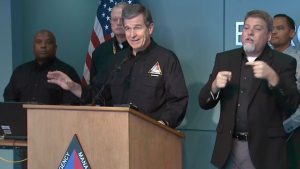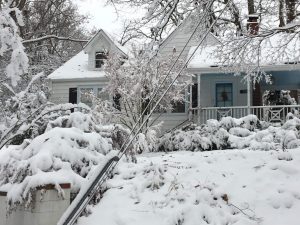North Carolina, where I live, has just come through a winter snowstorm. It was a bit unusual coming so early in the winter and it dumped a good amount of snow on our southern state, but it was, all said and done, just a snowstorm. Yet this rather ordinary storm produced enormous disruption, including an emergency declaration from our governor, and, sadly, at least three deaths. Final exams, at North Carolina State University were disrupted, with knock-on effects on student and family travel. Schools and child-care centers were closed for two days, some even longer, keeping parents from their work.

The contribution from climate change to this storm presumably was small – perhaps an incremental increase in the amount of snow that fell, fueled by the persistent anomalous warmth of the North Atlantic off our coast.
Yet the impacts of this storm point up how very vulnerable our state and its institutions have become. A message received once again following closely on the dire impacts of two hurricanes, Florence and Michael, earlier this year. If North Carolina is paralyzed by an ordinary winter snowstorm, how will we cope with the much bigger storms that are sure to come, fueled by continued climate change and warmer oceans?
Why are we so vulnerable? In fact, our vulnerability has the same root causes as the overall unsustainability of our society and economy, unsustainability which, in turn, drives our disproportionate contribution to climate change: Such causes include:
- Near total dependence on automobiles for transportation. When roads are slick, we are stuck. At my local supermarket Saturday, with the snow forecast to begin falling that night, I saw faces marked by real terror, a candid snapshot of the Long Emergency William Howard Kunstler predicted over a decade ago.
- Absence of planning and design. Not only do we depend on our cars, but we have built vast sprawling neighborhoods that will forever be inaccessible to any form of mass transit, so our car dependence will continue for decades or longer.
- An unwillingness or an inability to invest in infrastructure. More than 300,000 North Carolina households lost power in this storm. Why? Because our power lines are flimsily strung on wooden utility poles, with their pole top transformers exposed to the elements. If we had the will and means to invest, as is done, in much of the developed world, in resilient buried utility lines, presumably we could also be able to invest in the smart, low-loss electrical grid we need if renewable energy is to replace fossil fuels.
- The failure to use good information. Just as our nation ignores the projections of climate change, little was done proactively in response to the forecasts of this storm, which were accurate as much as a week in advance. As information from forecasts becomes increasingly decisive, escalating actions can be taken such that – for this case – supermarket shelves don’t empty and students get to take their exams on schedule.

Those who want to avoid the “controversy” of climate change often retreat to the language of adaptation and resilience. But even an ordinary snowstorm demonstrates that an unsustainable society precludes resilience and effective adaptation. Addressing climate change through resilience and adaptation is possible only if it comes with real steps towards sustainability – weaning ourselves from the private automobile, forward looking planning and design, investments in clean infrastructure, and the smart use of data and forecasts – the same things we must do in order to mitigate global warming.
